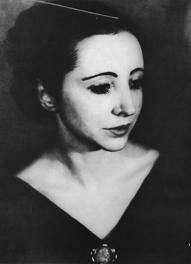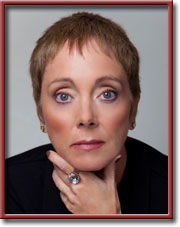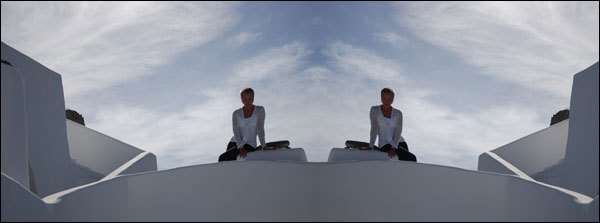Anaïs Nin & “The Furrawn”
“For a young woman writer who had lost patience with the clever, artificial and antiseptic prose of Updike, Mailer and the other anti-feminist, essentially anti-life “big boys” of American prose writing, Nin was an important figure. It was love at the first romantic line. I became an uncritical, unabashed admirer and (campy) camp follower.” Elizabeth Boleman-Herring
Ruminant With A View
by Elizabeth Boleman-Herring

 TEANECK New Jersey—(Weekly Hubris)—8/13/2012—In the last century, Andy Warhol said that the era had finally arrived when, thanks to our ravenous and restless communications media, everyone would be “famous” for 15 minutes. In our post-post-Warholian world, that window has, perhaps, telescoped (for most) to the length and breadth of a tweet.
TEANECK New Jersey—(Weekly Hubris)—8/13/2012—In the last century, Andy Warhol said that the era had finally arrived when, thanks to our ravenous and restless communications media, everyone would be “famous” for 15 minutes. In our post-post-Warholian world, that window has, perhaps, telescoped (for most) to the length and breadth of a tweet.
With the publication of Volume VII of Anaïs Nin’s Diary, I came into my own 15 minutes. Anaïs (pronounced Anna-eés, if you please), with her customary generosity, had pulled me, and the title of my still unpublished novel, The Furrawn, into the limelight. And she did so three years after her death of cancer in January, 1977.
Friends and former university classmates and colleagues phoned and wrote to me from—all over the world. “Good grief, Bebe,” said one: “You’ve got almost as many references in the index as Henry Miller.”
Another friend, who knew about Nin’s and my difficulties, said, “It was her way of saying how sorry she was.”
Much later, on a trip home to the United States from Greece, where I had happily expatriated, I went out to buy the book at last, and read the entries, in hot tears. Because Nin, from the time I was a 17-year-old college junior, had been my mentor (she, and Patrick Leigh Fermor). I had trusted her, followed her, and she had hurt me. And then she had died before I knew how unintentional her injury of me had been. Her last card to me, sent shortly before her death, was a silkscreen of two hearts, suspended in two adjoining cages, touching, but just barely. Inside, she wrote: “Dear Bebe, I’m getting well but so slowly? Still in bed—but able to enjoy visits pool [sic] and garden. Love Anaïs.” I do not know whether or not she received my reply to her card. I will never know whether or not she heard me say I was sorry my selfishness-expressed had been added to the burden of cancer she carried in those last years.
A university drama coach brought Nin to my attention in the late 1960’s, quite a while before her rediscovery. As a young writer, I had been keeping an intensive journal for years. Mr. Beasley thought I might like to read a contemporary diarist whose writing he said mine resembled: as Nin has since become “the best-known diarist since Samuel Pepys,” I was flattered by Jack Beasley’s comparison. When I began reading her work in earnest—both her Diary, and the remarkable, still underrated fiction, including Collages and A Spy in the House of Love—I was simply grateful to him for the gift of a role model.
Anaïs Nin, as emotional, as cryptic and, yes, as precious and self-absorbed as she can be, is also, at her sublime best, a visionary writer.
For a young woman writer who had lost patience with the clever, artificial and antiseptic prose of Updike, Mailer and the other anti-feminist, essentially anti-life “big boys” of American prose writing, Nin was an important figure. It was love at the first romantic line. I became an uncritical, unabashed admirer and (campy) camp follower. I wrote, sending parts of my own diary. She, keeping a pledge to answer all her mail, responded, encouraged, kept responding. She paved my way to agents, editors, publishers, kept me informed about her own work, her own problems. I was in my late teens; she in her late sixties. But, like every true mentor, by illuminating the path she had taken herself—as woman, as artist—she made the different path just ahead of me look brighter, more clearly sign-posted.
Finally, on April 28, 1972, in Rye, New York, we met face to face. (The occasion was a weekend meeting of around 40 mostly women artists, later documented in a book titled Celebration with Anaïs Nin.) In the presence of this dramatically dressed and beautiful, tiny woman, I was largely mute. All I could do was reach out for her hand and smile. What saved me from feeling like the star-struck lunatic I so obviously was, was that everyone reacted to Nin in about the same way. She was like some superannuated, sole member of a species of charismatic mega fauna who had long outlived her proper age.
And she reacted to us—with praise, exhortation, encouragement and, always, a finely tuned attentiveness. It was over all too soon, that symposium. The “celebrants” returned to their writing or sculpting or painting with renewed vigor. Nin, who kept in touch with all of us, reported in her letters on our continuing creative work. She acted as a sort of central clearinghouse for news of her brood’s successes. She nurtured our talents, and enabled us to inspire one another.
Looking back, it is how she functioned as a guide that I recall most fondly. And what I once interpreted as her injury of me, I have now come to grips with.
In an interview in Vogue magazine, torn out and sent to me by a friend, Nin used the title of my unpublished novel, The Furrawn, without mentioning the book, or its author, or how she had come to hear the term. A Gaelic word that means “the kind of talk that brings strangers to sudden intimacy,” and the title of a manuscript I had worked on from the age of 15, The Furrawn was something I’d come to look upon as my personal property. I asked Nin, in a wounded letter, how she could jeopardize my book in this way, and put something into the public domain that I felt was my own. Later, I learned that all Nin’s California lectures had been titled The Furrawn—that there was even a sailboat named for my book!
Of course, the operative words in all my angry squeaks to Anaïs were “I” and “me” and “mine.” She responded, first to a close friend of mine, saying: “I did not know that she felt it (the title) was her own secret; I always shared everything I discovered . . . it was done with love and with no intent to harm.” Then, she wrote to me, sanctioning my anger: “All of us have a right to be angry if we feel betrayed. Anger is not an ogre. You have not known me long enough to be sure of my faithfulness to friends . . . . No, I won’t use the word any more—but I have to teach, to talk about women’s writing, so finish your novel so I can say: Here, you see, woman writes to connect, to bring together.”
No, anger is not the ogre. Selfishness, however, is. It took me a long time to outgrow the feeling that I had been robbed. When I did, I realized the word I had unearthed in a library in Galway, Ireland, had only been mine-to-give-away, and mine-to-give-away to someone who could give it away again to so many.
In the years since her death, I have written literary criticism of Nin’s work and taught her books at the university level to young students as star-struck by her as I once was. I have reread her, sans lump in throat, and found I still admire her, without the pedestal. Anaïs, herself, hadn’t much enjoyed her role as 1970’s-style goddess. The succes fou inhibited her own creativity and growth.
These days, I’m just glad to have known the real woman, to have her insights and a record of her tremendous accomplishment in ink on paper. I only hope tangling horns with the hoarder in me didn’t overly distress her, because what it taught me was invaluable.
![]()
The Diary of Anaïs Nin, Vol. VII: 1966-1974. New York: Harcourt, Brace, Jovanovicb, 1980.
Celebration with Anaïs Nin, edited by Valerie Harms. Riverside, Conn.: Magicircle Press, 1973.


8 Comments
jerry
Lovely and enlightening ….gives me a personal introduction to Nin and more, more, more ammo for battling away at the crippling ego we should all be at war with. Your writing is always the work of an eyes-skyward forest sprite with laser scalpel in hand!
eboleman-herring
Jerry, that’s the nicest epithet any reader’s ever given me: “eyes-skyward forest sprite with laser scalpel in hand.” Right out of Shakespeare’s “The Tempest.” Thank you!!!! Just-Call-Me-Ariel :-)
Ted
This is beautiful and revealing on so many levels it is hard to enumerate them all. Foremost, it is your heartfelt public apology for a wrong you have felt guilt over for far too long. It is also a celebration of your admiration and love for this woman who inspired you, aided you, and encouraged you. In the telling, it shows that those feelings were reciprocated, and if she felt hurt by your misunderstanding of her intentions, she understood, and immediately forgave.
It also introduces us to a word we must incorporate into our vocabularies. I have the feeling that almost every conversation you have is a furrawn. How can we not use this word now? We have just read a written furrawn!
Perhaps this love letter to a long gone heroine will inspire others to read her wonderful prose. And perhaps that will inspire them to read others who poured their beings onto the page like Henry Miller and Lawrence Durrell, to name just two.
Finally, with love, may I suggest that perhaps you should consider dusting off that old manuscript that you started as a teenager and and honor Nin’s request and finish the damned book.
eboleman-herring
Ted, many, many thanks for this eloquent homage . . . to two women-writers. :-) I HAVE looked at the ms., again and again, and think the best thing about it IS the title. Hey, I was 18! Butohmygod, Miller and Durrell and Connelly and Nin DO hold up, after all this time (a blink, really), and I go back to them constantly. To them and others in their large circles. Finding that word in a dusty, dark, dim Univ of Galway library was a revelation. My head came off. And I’ve let it (word, not head) just languish. However, if you drive down to Lake Hartwell some time, you’ll find I named the road that leads to my family’s old homeplace “Furrawn Lane,” for the cognicenti. Love ya, e
L kolb
What a personal tribute – inspiring ………
eboleman-herring
Thank you, Laura Dear. She WAS an inspiration, and an enigma . . . but never, ever boring.
t
‘had a boat named Furrawn once, it brought people together.
and then I lost her whilst drinking….
eboleman-herring
I recall that vessel well, T. You wouldn’t lose her now. :-) e